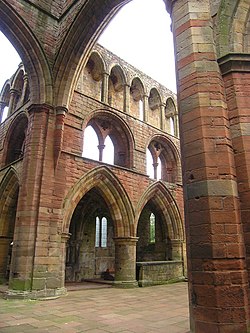Lanercost Priory

Lanercost Priory
|
|
| Monastery information | |
|---|---|
| Full name | Lanercost Priory |
| Order | Augustinian |
| Established | Ca. 1169 |
| Disestablished | 1538 |
| Diocese | Carlisle |
| People | |
| Founder(s) | Robert de Vaux |
| Site | |
| Location |
Lanercost, Cumbria, England |
| Visible remains | Nave; still used as the parish church, and impressive ruins. West range used as parish rooms |
| Public access | Yes |
Lanercost Priory was founded by Robert de Vaux between 1165 and 1174, the most likely date being 1169, to house Augustinian Canons. It is situated at the village of Lanercost, Cumbria, England, within sight of Naworth Castle, with which it long had close connections.
It is now open to the public and in the guardianship of English Heritage.
The foundation date was traditionally 1169, but can only be dated definitely between 1165 and 1174 on the evidence of charters. The dedication is to St. Mary Magdalene; unusual in the region.
It would seem the arrangements for founding the Priory were well advanced by the time of the foundation charter, as opposed to the more gradual process at Wetheral and St. Bees. Robert de Vaux gave the land of Lanercost "between the ancient wall and the Irthing and between Burth and Poltros, the vill of Walton by stated bounds, the church of that vill with the chapel of 'Treverman,' the churches of Irthington, Brampton, Carlaton and Farlam". The charter of foundation states that the benefaction was made for the sake of Henry II, and for the health of the souls of his father Hubert and his mother Grace.
Soon after the foundation of the house, Robert de Vaux granted to the canons the right of free election, so that when the lord prior died the person on whom the choice of the canons or the greater part of them fell should be elected in his place.
The bulk of the church building dates from the late 13th century, though there is evidence of earlier work. The Priory buildings were constructed, at least in part, from stones derived from Hadrian's Wall, including a number of Roman inscriptions that were built into its fabric.
The proximity to Scotland inevitably had an effect on the fortunes of the priory, and it was a target of Scots attacks in retaliation to English raids. This became acute after the outbreak of the War of Independence. In 1296 the Scottish army encamped at Lanercost after burning Hexham priory and Lambley nunnery. The Scots were interrupted before the damage could become great, and they retreated through Nicolforest, having burnt some houses of the monastery but not the church. Similar depredations under Wallace continued the next year and led to calls for reprisals from the English.
...
Wikipedia
